|
By Jill Smith First of all, thank-you to the wonderful crew (Captain Ron, 1st mate Jason, Adam, Jill, Charlie, Tohru, Scott, Yari, Jesse, and Tom), who made our week extra special; it was one that we will never forget thanks to you!  Crew Update For some divers who have been on the Aquacat before, you will remember Jill and Adam, and we were so happy to see them again! What a happy surprise to find out that they are a couple now (super adorable), and have some big plans for their future! Jill and Adam are investing in gear and equipment to launch their business and travel adventures! They will be travelling and taking beautiful macro, artistic, abstract underwater photography quite unlike anything else. They are also looking forward to creating some very unique travel vlogs, blogs, and books for the discerning traveller who appreciates some creativity and humour with their research efforts. They are still in the preliminary phases of this endeavour, but I will share their website and Facebook page when they get it going – Peru will be first on their travel list this winter, so I look forward to experiencing Peru through their eyes. Good luck Jill and Adam! Favourite Dive Site – Austin Smith wreck The first time we visited the Austin Smith in 2014, it was still intact, but on October 6th of 2015, Hurricane Matthew blasted the Bahamas, causing extensive damage to the area, and breaking the Austin Smith wreck in two. It still remains a beautiful site to dive, with sharks frequenting the area, and a lot of life thriving both on the wreck and the nearby reef. I had the happy privilege of diving this site with my son Sam; so we entered the water and made our way to the mooring - I am doing my mapping project on the Austin Smith wreck for my divemaster program, and our plan was to start at the mooring pin so that I could count fin kicks to the stern of the wreck to estimate distance, followed by a slow and brief ascent to 25 feet over the wreck so I could get a birds-eye view photo, followed by more wreck measurements - however, we were distracted by a very friendly grouper who approached us directly, and I lifted my camera to take a portrait, but he got between my camera and my face, looking into each of my mask windows in turn - he was too close to photograph! He swam around our heads, and when Sam offered a hand, he went straight to it, and only sat still to be petted. What a fish! He clearly wanted to be stroked, and harassed divers until he got a pet! I tried to continue counting my fin kicks, but then felt strong yanking on my bikini strings at my neck – the little stinker untied the bow of my strings (when we surfaced Sam reminded me to do it back up as he did not wish to be scarred when I removed my wetsuit)! We definitely had to take some time out of our plan to interact with Fred (the friendly grouper), and he was the delightful highlight of the dive hands/fins down! A Whale (shark) of a Surprise At Crab Mountain dive site, about half of the divers had the great pleasure of a whale shark encounter! What a very rare and special treat! The other half of the divers were either in the swim through, or (ahem), looking too closely in the little cracks of coral for shrimps and crabs. James was the first diver to come up and tell Adam that he saw a whale shark as Adam hosed him down, and Adam called him a liar! When diver after diver came up extolling the virtues of their wonderful whale shark experience, he began to think maybe there had been a whale shark after all! Our divemaster and guide, Jill (a different and wonderful Jill), was in the swim through, and had a spectacular temper tantrum at the surface when she discovered what she missed!!! Good times. David White captured the photo featured at top for our viewing pleasure. Full Moon, Ostracods, and Sparkling Universe We did have a full moon on this trip, and after the night dive was over and the boat was quiet, I spent a little time at the boat railing enjoying the breeze and the view. I was admiring the very slight glow of the reef areas; the coral heads were glowing ever so slightly. As I lingered and my eyes adjusted further, I began to see blinking lights in the water – it looked like a starry night sky with the stars blinking on and off – ostracods! Ostracods are very small crustaceans that will rise close to the surface during a full moon (and for a few days after) in the Caribbean to find mates with their bioluminescent vomit. Yes, that is correct – blobs of bioluminescent vomit emitted by the males to impress the females. Sometimes I'm glad to be human. Regardless of that little detail, it was beautiful, and I went to fetch Jody and tell the others. What a romantic moment – instead of watching the starry sky, we watched the light show in the water, and it was perfectly appropriate for all of us who are drawn to the ocean. It’s moments like those that make me feel very small in this miraculous universe, and very fortunate to be able to witness some of its wonders. I hope everyone has enjoyed a beautiful Christmas with loved ones, and that the new year brings you happiness, joy, and some new and wondrous surprises. A few photo highlights of the week. Photo Credit: Jill Blanchette
2 Comments
ONE 1. Meditation Being a scuba diver and learning to consume less air on your dives, means regulating your breaths. I often practice slow breaths; breathe in to the count of 4, and a slow, controlled exhale to the count of 5. I definitely notice I consume less air, but I also notice that getting into that rhythm is very relaxing. Because I am underwater, AND breathing through a regulator, inhaling breaths are a little louder. And exhaling bubbles is just fun! My husband is a scuba instructor, so he has logged countless dives in his scuba career. He is a very patient buddy as I take pictures of the many critters we encounter, and I often turn around after taking my shots, and he literally appears to be napping, hands clasped, suspended perfectly by my side. The first time I noticed that, I thought he was "narced", staring senselessly at the rock in front of him, but no. He was just resting his eyes while I took pictures. THAT is taking relaxation to a whole other level! On our last dive in the Cayman Islands, we settled on the sandy bottom of the ocean, and patiently waited for the little yellow-headed jawfish to cautiously stick their heads out of their holes. They are curious, and it was our hope that they would come all the way out. I have a little photo-series of those relaxing moments (see below, and sorry, I didn't have macro capability, so I couldn't get any closer), but my point is, that is was such a calming practice (plus, these little guys are so darned amusing!). It is a place of ZEN. :) Cute and curious Yellow-headed Jawfish - The "dance" we had the privilege of watching as we meditated on the bottom of the ocean: TWO 2. Escape Technology Don't get me wrong, technology is great, but enough already! I use technology a lot for my job, and for the business; social media is a big part of being involved in the scuba industry. That makes sense, because it is a very unique sort of business - a very social business. But it has some tremendous downsides. I began to feel like I couldn't do it all. I had mountains of work to do, but somehow the social media vortex would suck me in, and spit me out hours later. It was creating stress. Disentangling ourselves from social media while we go on our diving excursions is such a relaxing pleasure! No phones underwater! We naturally find ourselves unwinding and enjoying the company of other divers, while the "pull" of technology lessens minute by minute. I LOVE our little dive trips! Whew!!!! What a relief to escape! THREE 3. Silence Silence is golden. It really is. Noise is a pollution, and we are so inured to it, that we often don't realize the strain and stress we are putting on ourselves emotionally and physically, until we finally free ourselves from it. To descend below the surface of the water, is to truly shut out the rest of the world. No work, no bosses, no technology, no traffic (except for schools of fish), and, for a little while anyway, I can pretend there are no bills. It is an escape like no other. Bliss.  Jody in the recompression chamber of the Kittiwake Rescue ship - Grand Cayman Jody in the recompression chamber of the Kittiwake Rescue ship - Grand Cayman FOUR 4. History Wreck diving is a favourite for many divers. People love them for many different reasons. For some, it is the magical timelessness of a structure preserved in its time (although it is ever changing from year to year). For others, it is the historical significance that demands their fascination. A wreck may lie on the bottom of an ocean as a memorial to battles, conflict, or tragedy, and historians have learned a great deal about our past from the archaeological artifacts recovered and preserved from its depths. Every wreck has a story. We love to learn the history of each one before we explore her secrets. And wrecks are everywhere! We enjoy them on weekend outings from home here in Ontario often throughout the summer, and in the winter, we explore historical wrecks in more exotic and far away locations. Each is unique, and although people usually think of ships as wrecks, we also dive the wrecks of planes, military craft, and even railroad cars! Wrecks draw underwater photographers, not only for its structural beauty, but for the life that is sheltered there. In the ocean, wrecks become artificial reefs over time - a kind of coral nursery - and with each passing year of thriving growth, more and more marine life takes residence there. It is beautiful to see and appreciate the contrast of a dilapidated wreck that is falling apart, with the colourful coral growing on it, attracting fishes, shrimps, eels, rays, and more. What's not to love?  FIVE 5. Marine Life Do we all carry an obsession with the water and the creatures living in it, or is it just me? I can't walk by a body of water, without at least visually searching its depths for a glimpse of life. In fresh water - frogs, tadpoles, crayfish, and, of course bigger fish like bass, or maybe sturgeon? In salt water - jellyfish, sea-turtles, lobster, or maybe even a shark? I want to see them, I want to see them all! My marine life point BEGS to be told through a few pictures (which will naturally lead to point number 6... SIX 6. Underwater Photography I know, it's not every scuba diver's passion to capture the beauty of the world below the waves with a digital camera, but it IS mine! It's really one of the motivating factors that got me into the sport in the first place! Many divers choose not to take a camera with them, because they just want to enjoy the experience first hand, not through the eye of the camera. They will tap their heads and proclaim, "It's all up here." And they are right. But not for me. I am DRIVEN to improve my underwater photography skills. If I can't take my camera with me, I am devastated, because then I KNOW that is when I will see something cool, and miss the chance to photograph it through MY eyes, MY way with MY tool - the camera. And generally speaking, you just can't plan what you are going to see and photograph on a dive. It's like Forest Gump says, "Scuba diving is like a box of chocolate - you never know what you are going to get." (close enough). So with camera in hand, I must be ready. For anything. Every dive and photo-shoot experience is a learning opportunity, and I leave every excursion with a list of things in my head that I could improve on next time. Things I would do differently, and things I would like to try. It may be an obsession. My scuba trips are fraught with running to my room to check O-rings, download images (with back-up) and charge lights and camera so they are ready for the next dive. And I just wouldn't have it any other way.  Jim's underwater yoga moves! Jim's underwater yoga moves! SEVEN 7. Divers are Fun and Cool But it's just so simply true. Divers love life. They are fun loving. They love nature. They care about the ocean and the environment. We take care of each other and help one another to improve their scuba skills, and dive safer. We enjoy BBQ's and refreshments after many dives, and they are just a pretty cool bunch of people. You really have to join this community and see for yourself! What are you waiting for? Learn to dive, or join the scuba club! 905-898-5338 email: [email protected]  Scuba diving? It's just like riding a bicycle! Scuba diving? It's just like riding a bicycle! Sunset House What a great week of diving we are enjoying! The best part about the Sunset House, and diving with Sunset Divers here in Grand Cayman, is that while a two-tank boat dive is included every morning, there is unlimited shore diving just a few feet from our rooms, and the reef just offshore here is alive and beautiful! Steve jumped in from dive deck the other night, and came face to face with an octopus and two cuttlefish, and he hadn't even started his dive yet!  Steve and the mermaid - Selfie! Steve and the mermaid - Selfie! We are seeing plenty of awesome marine life, and the mermaid statue and the Nicholson (a carrier wreck), are close to shore from our resort, so we may visit them often. If we wish. And IF we can find them...Jim... Be careful with the mermaid, Jody put his arm around her for a picture and got stung by some fire coral. It may be ok now, as some young male divers were heading out to clean off her nipples. Maybe they will clean off more... Last night, Jim found two lionfish mating (he has good eyes), and while they sort of separated by the time I glided in with my camera, you can see from the picture that they change colour when they are...um...mating. It was so interesting, we had never seen that before. Can you spot them? Yellow-headed Jawfish (Why did the diver need a macro lens? - To get these guys sharp!  The Kittiwake The Kittiwake But our favourite dive has been on the USS Kittiwake (ASR-13). It was a United States Navy Chanticleer-class submarine rescue vessel in commission from 1946 to 1994. In 1986, the Kittiwake recovered the black box from the Space Shuttle Challenger disaster. We get to do the Kittiwake tonight for a night dive, so we are off with our cameras...  Here we are in the head of the Kittiwake, where the mirrors still hang on the wall, albeit cracked and distorted. After that, just a little bit down the hallway, there is a recompression chamber where the rescue ship was able to treat divers on-site. There is a little pocket of stale air in the chamber, but keep your regulator in your mouth, and don't breathe it! Intruder (nurse shark) in moray eel's home: 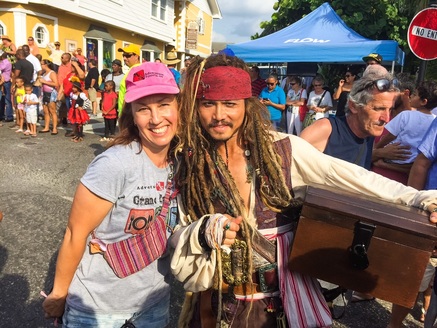 Jack and Jill Jack and Jill Aaargh, A Scurvy Pirate! It was pirate week in Grand Cayman when we were there - such fun! The pirates sailed in on Saturday at 3:00 pm, and fought sword to sword with the British redcoats, only to overcome them and kidnap the Governor, whose daughter is in love with a pirate. The pirate parade ensued. The town was over-run with pirates, and Captain Sparrow himself joined in the raid! This Friday, "My Bar" at Sunset House Scuba Resort, will be raided by the pirates mooring just off-shore, and the bar staff and guests will have to fight to defend it! But they will lose, and the pirates will shove off, only after enjoying a good, stiff drink! A great time!  Captain Lee and Instructor Aaron, getting us to our 1st dive of the morning! Aaaargh! We love to scuba with them! Captain Lee and Instructor Aaron, getting us to our 1st dive of the morning! Aaaargh! We love to scuba with them! Thank-you to the Sunset Divers Staff! We would like to thank the crew responsible for giving us a wonderful scuba experience while we were in Grand Cayman! Lee and Steve were excellent Captains, and we tried to be a good group for them too. The dive briefings were excellent, with Aaron's "towel art" featuring the beautiful geographical topography of our dive sites. Aaron was also an excellent scurvy pirate, and we enjoyed his soothing "radio-voice"! Andrew, and Solamay (spelling?) were so helpful and accommodating, making each experience a very special pleasure. Many thanks to a great team at Sunset Divers! So you have jumped on the scuba diving band wagon and have fallen in love. Congratulations, and welcome to the beautiful world of scuba diving! You have had your first breaths underwater and you’re hooked! Every instructor and Divemaster have started where you are now. We all have to start somewhere, right? An initial spark of interest in scuba diving can lead to a lifetime passion. We have compiled some tips and advice for you to use as a reference as you embark on your new journey into the scuba diving world. 1. Go Slow Relax and enjoy the experience. It’s not a race to be faster then everyone else, move slowly and take in your surroundings. You will notice that your air consumption will decrease if you relax and take it easy. Add air to your BCD in small increments, wait a few seconds, and see how the air you have added changes your buoyancy. Add a few more puffs, take a few breaths and reassess. Remember, you don’t need to add air to your BCD to ascend, use your fins instead and slowly release expanding air. 2. Air Hog? Want Better Air Consumption? The answer to your questions - log more dives. It is as simple as that. It’s natural to breathe more and consume more air when you are a new diver; the more excited and nervous a diver is, the more air they will inhale. This is normal and happens to most people new to the sport. The good news is, your air consumption will improve and it’s important not to get to discouraged. As you gain more experience, you will become more comfortable with your gear, and develop better buoyancy control. And it will become second nature after a while! Think about when you first started driving as a teenager -- you may have had a similar experience. 3. Don’t be peer pressured. Taking up scuba diving should be exciting and stimulating, and it is a great way to push your personal boundaries. While you’ll want to embrace new experiences in diving, don’t allow others to pressure you into doing something that doesn’t feel right. Any diver can call off any dive for any reason, no questions asked. Respect the fact that sometimes it is not safe to dive, and there will be times when you need to call a dive. Also remember that if something doesn’t feel right, then it probably isn’t. Trust your gut. 4. Get a well- fitted mask. You might not think it’s a big deal, but I can assure you that the biggest diver complaint is a leaky and uncomfortable mask. The whole point of diving is to see underwater, right? If you are always having trouble with a leaking and/or foggy mask, it will distract you and impair your vision. Sometimes finding a well-fitting mask can be a hit or miss. Take the time to try on different kinds of masks, until you find the perfect one. Try on different masks in the pool and figure out which style is the right fit for you. 5. Control your weight. Now I’m not telling you to go on a diet here, we are talking about the weight in (or on) your weight system. It is commonplace for new divers to overweight themselves, which will in turn make your diving experience a lot more difficult. Take the time to experiment and fine tune your weighting. The payoff is neutral buoyancy throughout your dive. Neutral buoyancy is the sweet spot, the holy grail of being a good diver. Once you find that sweet spot, everything seems to come together. Come to a Monday night pool session and experiment with different weights. When you find that perfect weighting and have achieved neutral buoyancy, it will keep you from bumping into reefs, help with controlled descents, reduce the risk of ear injuries, and also improve your air consumption dramatically. 6. Equalize Early & Often. Another common complaint in new divers is ear discomfort when descending. If you descend faster than your ability to equalize, you will put yourself at risk for an ear injury. Use a descent line to help gauge your speed. The moment you feel any discomfort, stop and go back up a little bit, until you can equalize and you no longer feel discomfort. Do not keep going and hope the pain will go away – IT WON’T. If you really can’t equalize, it is time to signal your buddy and call the dive. Only continue when you can equalize the pressure in your ears. Pushing your ears past their limit can cause serious injury and it is not worth the risk. 7. Keep Diving – Continue Your Education Practice, practice, practice, and log more dives. Just like any new hobby, practice is the key to mastering a skill. Every minute you spend underwater, you are becoming a more experienced diver. With every dive you will learn something new, see something different and experience new environments. A great way to improve your skills is to enroll in the PADI Advanced Open Water Course, which is the next step up from PADI Open Water Diver. The PADI Advanced Course involves theory and 5 dives, each dive introducing you to different specialties. Some options include: deep, navigation, wreck, night, boat, and peak performance buoyancy dives, and there are many more that might spark your interest. The PADI Advance Open Water also lets you go deeper (to 100ft/30m), which lets you experience deeper wrecks and environments. And there you have it newbies! You are well on your way to becoming experienced divers! We all start from the bottom, we all get nervous sometimes, and we are not all perfect divers. Every diver has strengths and weaknesses, like most things in life. The best advice I can give you is to practice your little heart out, find your perfect weight balance, and move up in the diving world. Diving should be fun and exhilarating, not stressful. Unlike most activities, diving brings a whole different level of benefits. Which form of exercise lets you swim with sharks? What other hobby lets you explore a 100 year old ship wreck? None that I can think of! Safe & Happy Diving! Dana Lenahan |
FlickrAlbumAuthorsJill Smith Archives
January 2024
Categories
All
|
Our Services |
Company |
SupportOur Blog
|
|
Copyright © 2014
|
Newmarket, ON
|
(905) 898 5338
|

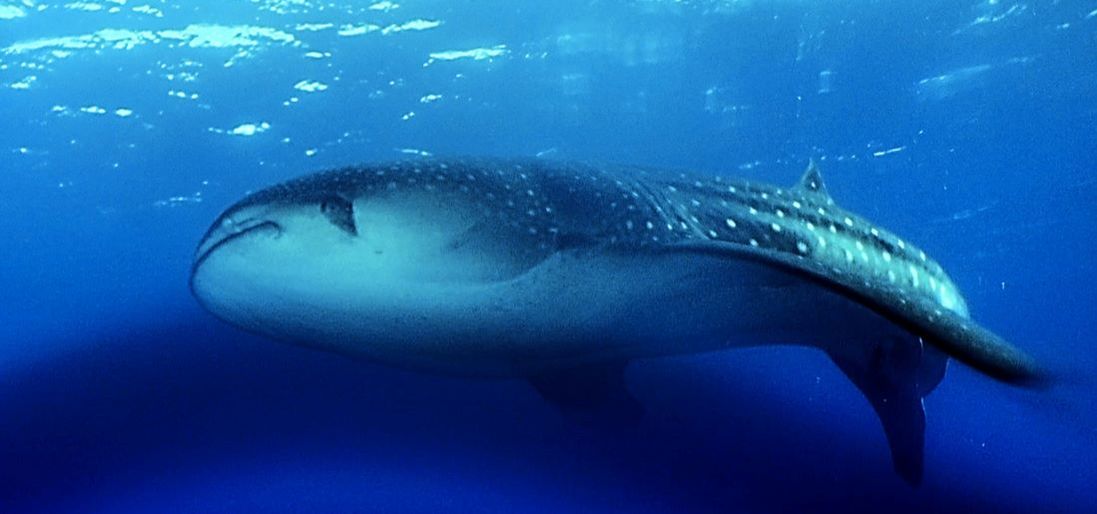





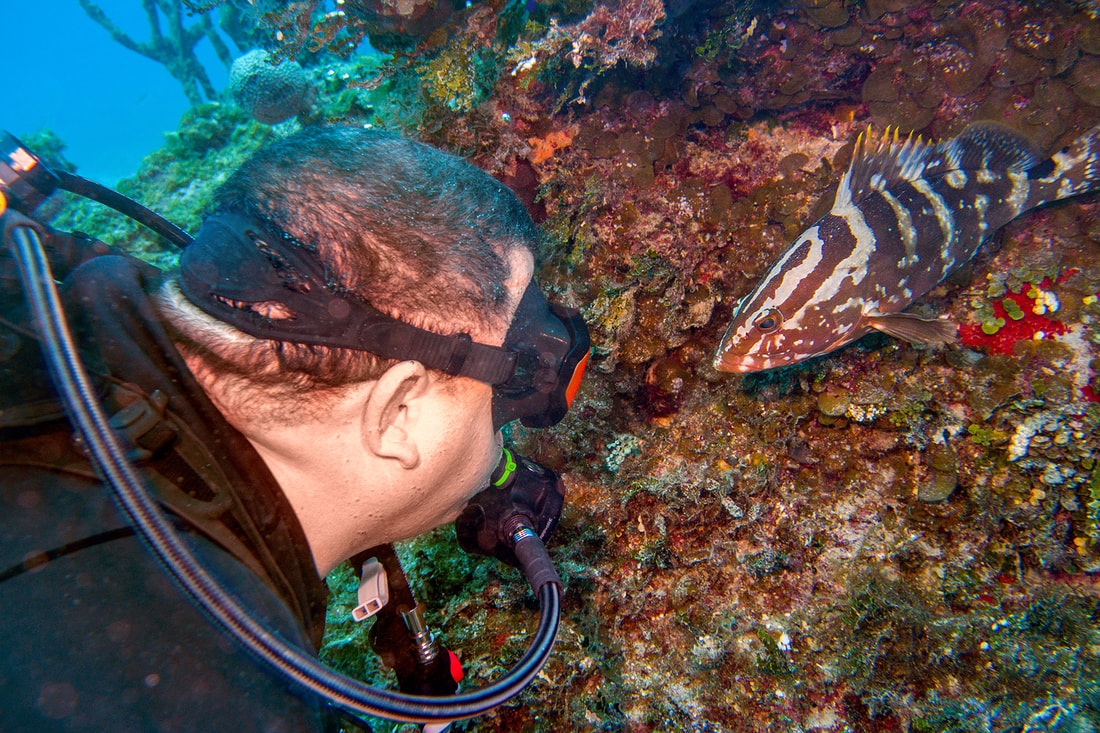










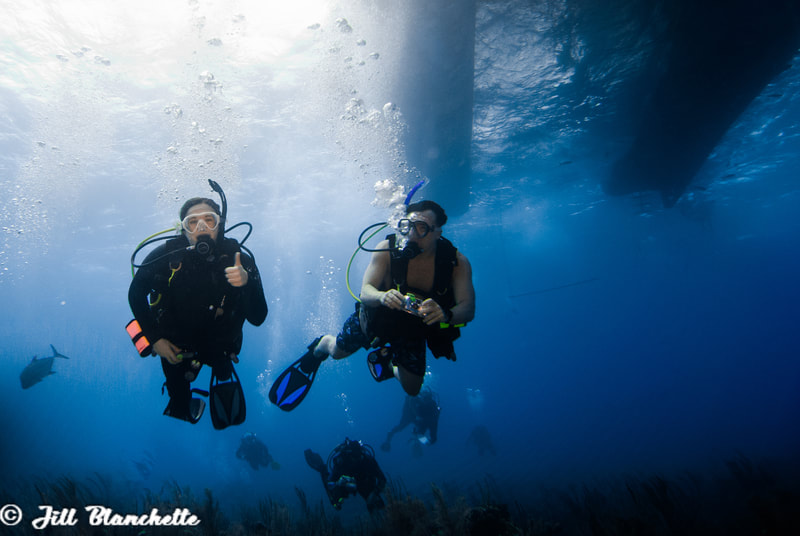


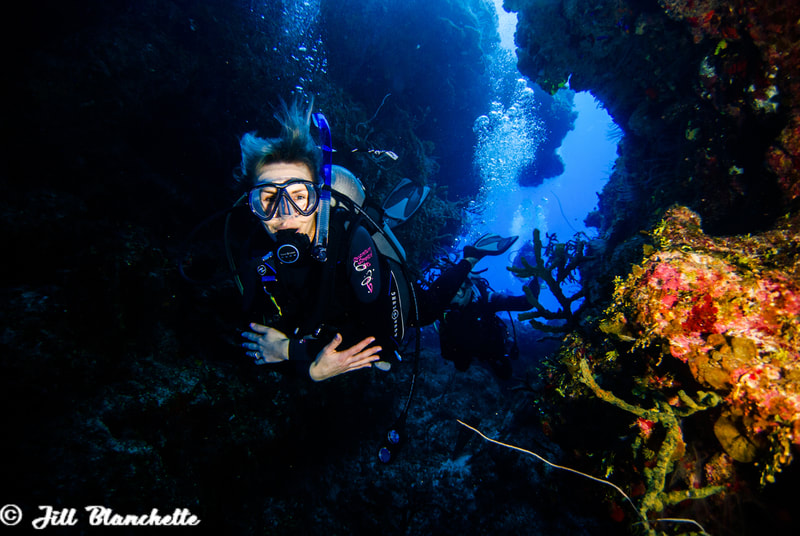










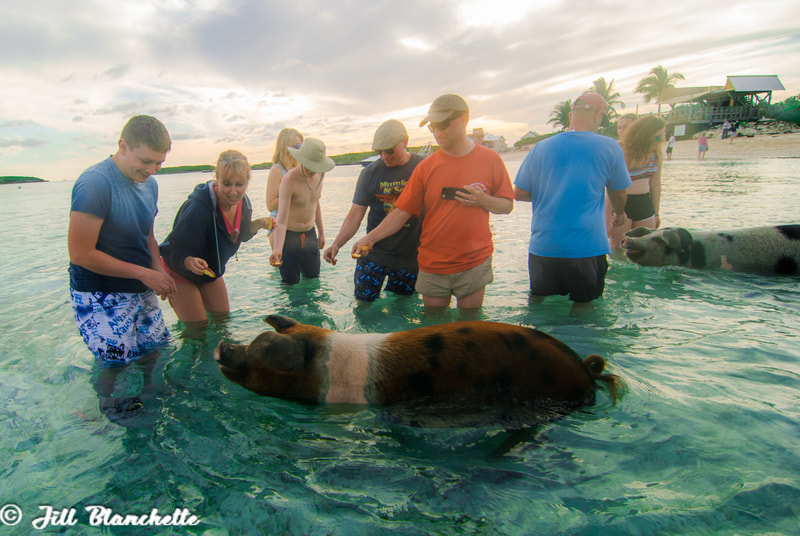

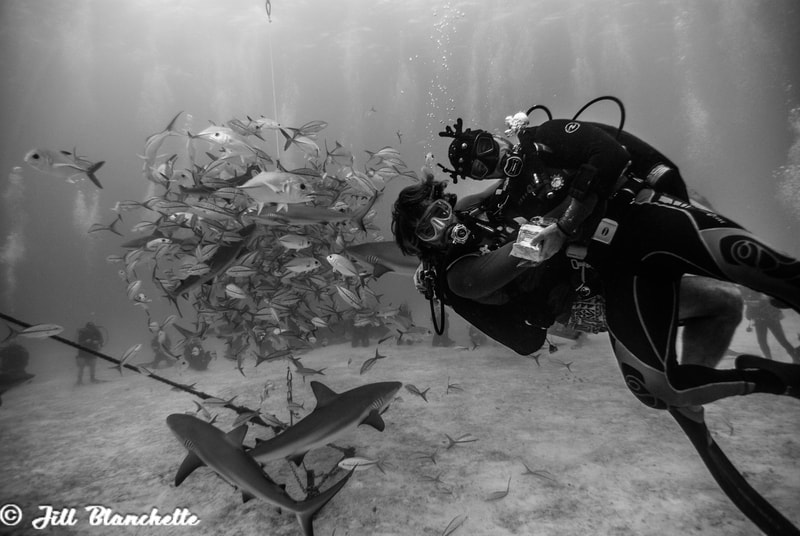

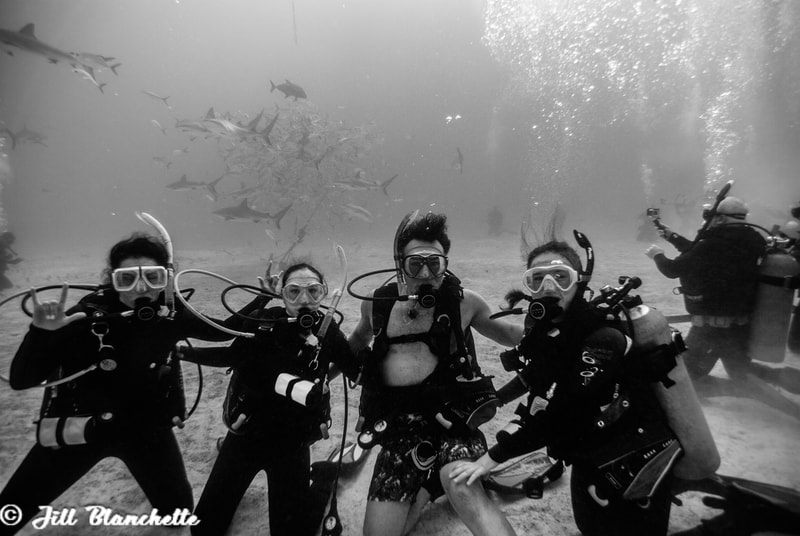






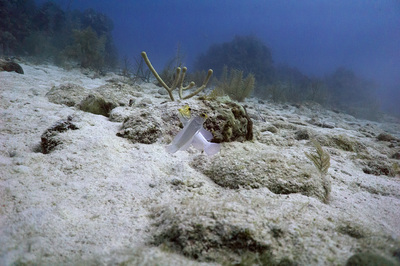






















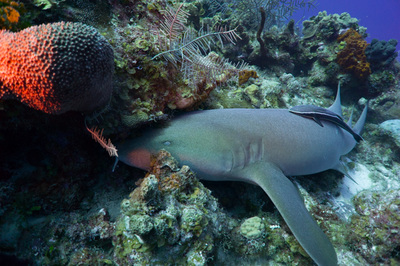


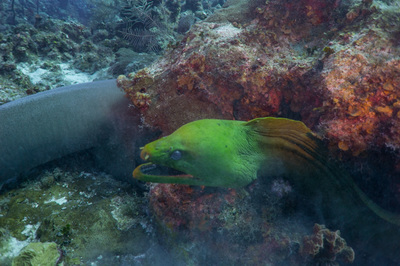









 RSS Feed
RSS Feed

